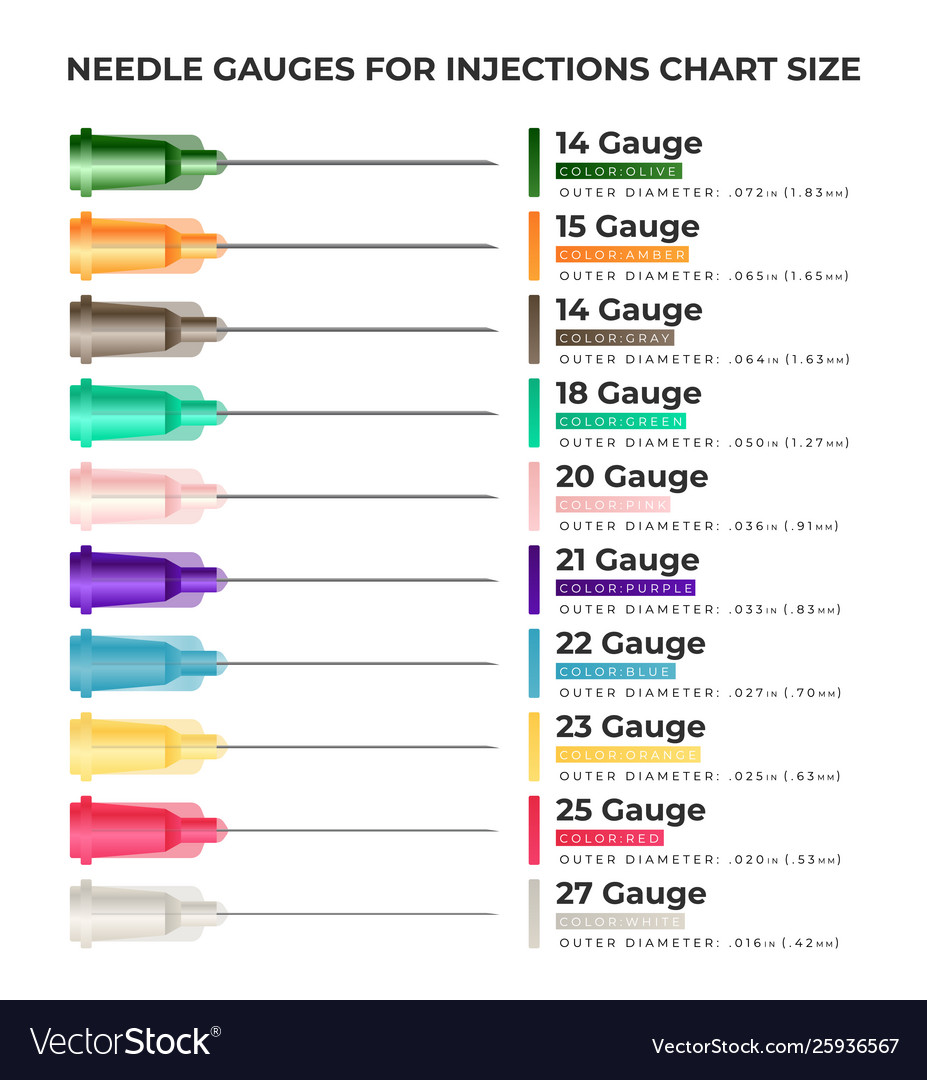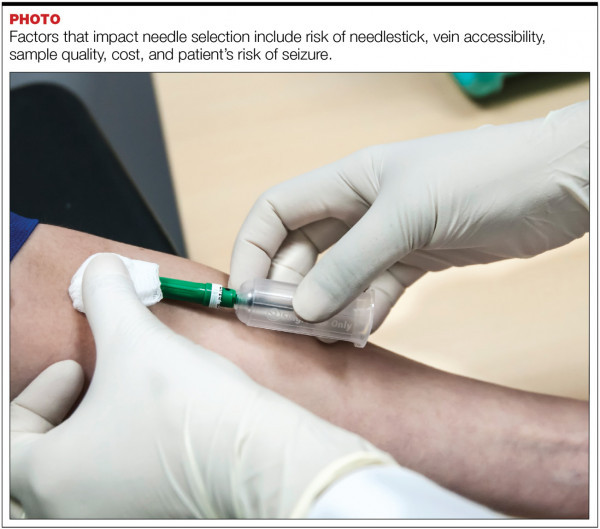Size Of Needles For Blood Draw, For most patients, their veins are of a size and stability that is best suited for the 21g needle.
Size Of Needles For Blood Draw - Sometimes blood tests can be done as a “fingerstick” test. Web the 21 gauge needle is the standard gauge needle for drawing blood. Web the size of the butterfly needle is measured in gauges. The larger gauges are used for thicker blood or larger veins. At the same time, it must be thin enough to be comfortable for the donor. Opting for a smaller gauge needle can help reduce discomfort for patients with delicate veins. Multiple drawing (evacuated), hypodermic, or butterfly needles. Web below is a needle gauge chart showing the sizes of needles used for the evacuated tube system, syringe method, and the butterfly needle when performing venipuncture. Naturally, preferences vary from practitioner to practitioner, but many phlebotomists prefer to use straight needles with adults. The red blood cell (rbc) count. Web the common butterfly needles are 1/2 to 3/4 inches long and come in a range of gauges, with 21 and 23 gauge the most frequently used. It is often used for procedures that require a larger amount of blood to be drawn quickly. Web for blood donations, the chosen needle must be thick enough to allow blood to flow. Web the common butterfly needles are 1/2 to 3/4 inches long and come in a range of gauges, with 21 and 23 gauge the most frequently used. While the size can vary, most needle sizes are 21 to 23 gauge. When she grabs the pot of boiling water, one deputy steps back “away from your hot steaming water,” he says.. These sizes are chosen because they strike a balance between being large enough to allow for a sufficient flow of blood and small enough to minimize discomfort for the patient. Those veins are usually big enough for the use of a 21 gauge needle. Web the most common sizes include: Naturally, preferences vary from practitioner to practitioner, but many phlebotomists. Web a butterfly needle, also known as a scalp vein set or winged infusion set, is a device used to draw blood from a vein or deliver intravenous (iv) therapy to a vein. Web blood collection needles, though modest in appearance, are indispensable tools for drawing vital blood samples, forming the foundation of accurate diagnoses and medical interventions. 1 the. The smallest gauge, 25, is used primarily with pediatric patients. Web below is a needle gauge chart showing the sizes of needles used for the evacuated tube system, syringe method, and the butterfly needle when performing venipuncture. Web by understanding the different needle sizes and factors to consider when choosing a needle size, phlebotomists can ensure safe and efficient blood. The smaller the number, the larger the needle is. This comprehensive guide aims to shed light on the nuanced process of choosing the appropriate blood collection needles. “i rebuke you in the name of jesus,” she says in response. Those veins are usually big enough for the use of a 21 gauge needle. Web for blood donations, the chosen needle. The red blood cell (rbc) count. Butterfly needles come in various gauges, ranging from 18 to 27 gauge. It is commonly used for patients with normal to moderately fragile veins, as the thicker gauge can help with blood flow. The 21 gauge butterfly needle is one of the thickest options available, making it suitable for patients who require a larger. The larger gauges are used for thicker blood or larger veins. Web for blood donations, the chosen needle must be thick enough to allow blood to flow freely. Web what phlebotomists prefer. This comprehensive guide aims to shed light on the nuanced process of choosing the appropriate blood collection needles. Web optimizing needle sizes for diverse patient needs. The smallest gauge, 25, is used primarily with pediatric patients. Opting for a smaller gauge needle can help reduce discomfort for patients with delicate veins. Referencing a phlebotomy needle size chart can help phlebotomists select the right needle size for various clinical scenarios. These sizes are chosen because they strike a balance between being large enough to allow for a. Those veins are usually big enough for the use of a 21 gauge needle. Sometimes blood tests can be done as a “fingerstick” test. Web most butterfly needles range from 18 to 27 gauge. The one chosen will depend on whether the person doing the blood test has good veins or difficult veins. Web the size of the butterfly needle. Web the most common sizes include: This is the largest needle size commonly used for blood collection. Multiple drawing (evacuated), hypodermic, or butterfly needles. The larger gauges are used for thicker blood or larger veins. The gauge is small enough in which it does not cause any significant pain or discomfort during use. Web what phlebotomists prefer. The right needle size ensures a smooth and efficient donation process. Web by understanding the different needle sizes and factors to consider when choosing a needle size, phlebotomists can ensure safe and efficient blood draws for their patients. Referencing a phlebotomy needle size chart can help phlebotomists select the right needle size for various clinical scenarios. A butterfly needle consists of a very thin needle, two flexible “wings,” a flexible transparent tubing, and a connector. The choice of gauge depends largely on the patient’s vein size and the viscosity of the blood. The 21 gauge butterfly needle is one of the thickest options available, making it suitable for patients who require a larger needle size for blood collection. Occasionally, it can be hard to find a vein, so the technician may need to try more than once. These sizes are chosen because they strike a balance between being large enough to allow for a sufficient flow of blood and small enough to minimize discomfort for the patient. In this article, we will discuss the importance of needle selection in phlebotomy and provide a needle size chart to guide you in choosing the appropriate needle for different types of blood draws. Web the common butterfly needles are 1/2 to 3/4 inches long and come in a range of gauges, with 21 and 23 gauge the most frequently used.
Butterfly For Drawing Blood Draw. Imagine. Create.

Inspira Needle Guide

Needle gauges for injections chart size Royalty Free Vector

Needle Gauge Size Chart E Phlebotomy Training

Needle Gauge Sizes Alan Paige

Exel International MultiSample Blood Draw Needles Green Hub; 21 G x 1.

Sterican Blood Drawing Needles Buy Here
![]()
7 Common Mistakes of Nurses When Doing Blood Draws Nurse List

Phlebotomy Syringe Draw Procedure Blood Collection (RxTN) YouTube

Proper Needle Selection for Blood Collection September 2019
This Size Is Also Considered Large And Is Commonly Used For Blood Donations Or Blood Transfusions.
It Is Often Used For Procedures That Require A Larger Amount Of Blood To Be Drawn Quickly.
1 The Short Needle Length Allows The Phlebotomist To Insert It At A Shallow Angle That Can Increase The Ease Of Use.
Remove The Needle And Cover The Area With Cotton Or A Bandage To Stop The Bleeding.
Related Post: